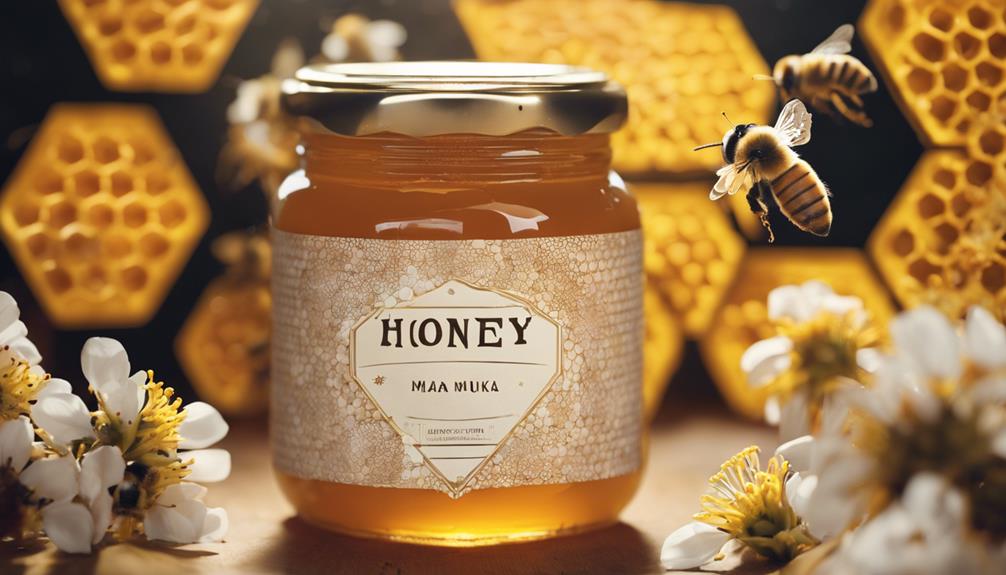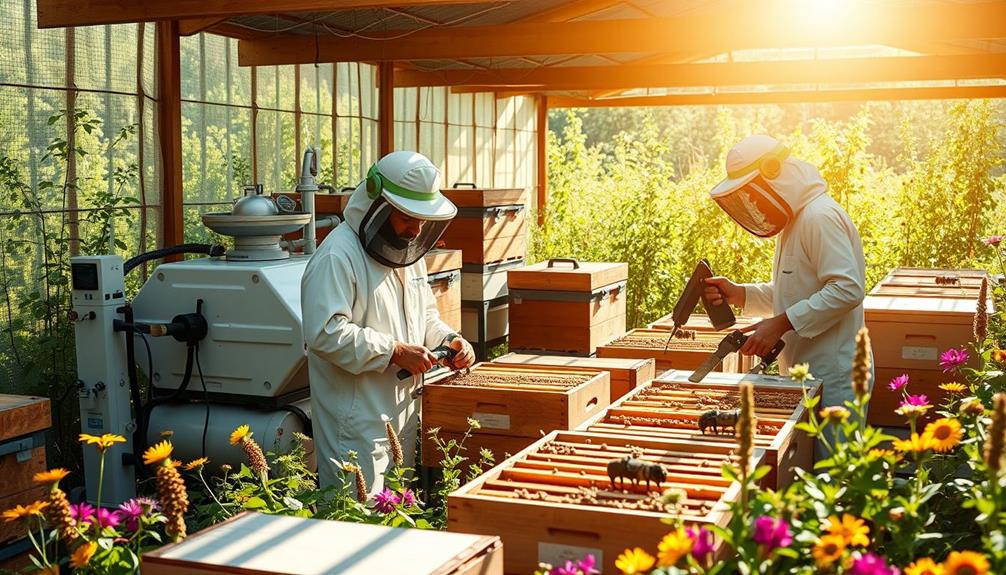To effectively price honey for wholesalers and retailers, consider several key strategies. First, account for production costs and desired profit margins while setting prices between 4 and 25 CHF/kg, depending on quality. Implement volume discounts of 10-20% to incentivize larger orders. Analyze competitor pricing to guarantee you remain competitive in the market. Additionally, clear pricing structures that reflect the value of premium products can enhance appeal. Remember to stay flexible and adjust for seasonal demand. You'll discover even more valuable tactics to enhance your pricing strategy as you explore further.
Key Takeaways
- Establish competitive pricing within the range of 4 to 25 CHF/kg, considering quality, packaging, and market conditions.
- Implement volume discounts of 10-20% to encourage larger purchases and enhance customer loyalty.
- Utilize tiered pricing structures that reward bulk orders and align with production costs.
- Monitor competitor pricing and market trends to adjust strategies dynamically throughout the year.
- Engage with customers regularly to build relationships and communicate special promotions or new products effectively.
Understanding Honey Pricing Factors

When it comes to pricing honey, several key factors directly influence what you can charge. The average wholesale price for high-quality honey is around 4 euros per kilogram, but this can fluctuate based on supply, demand, and quality assurance measures.
You'll need to take into account production costs, including labor, equipment, and hive maintenance, as these can greatly impact your profit margins when selling to wholesalers. Additionally, understanding the health benefits associated with honey, such as its antioxidant properties, may enhance its perceived value (health benefits of honey).
Keep in mind that wholesalers often expect lower prices per unit due to bulk purchases, so managing your production and inventory effectively is essential to maintaining profitability.
Additionally, the floral source, region of production, and market competition play critical roles in determining your pricing strategy. Understanding local market dynamics and consumer preferences can help you set competitive prices.
Establishing a transparent pricing structure is fundamental. Wholesalers require accountability for the product's quality and safety, so ensuring consistency in your honey's quality will build trust and foster long-term relationships.
Effective Pricing Models
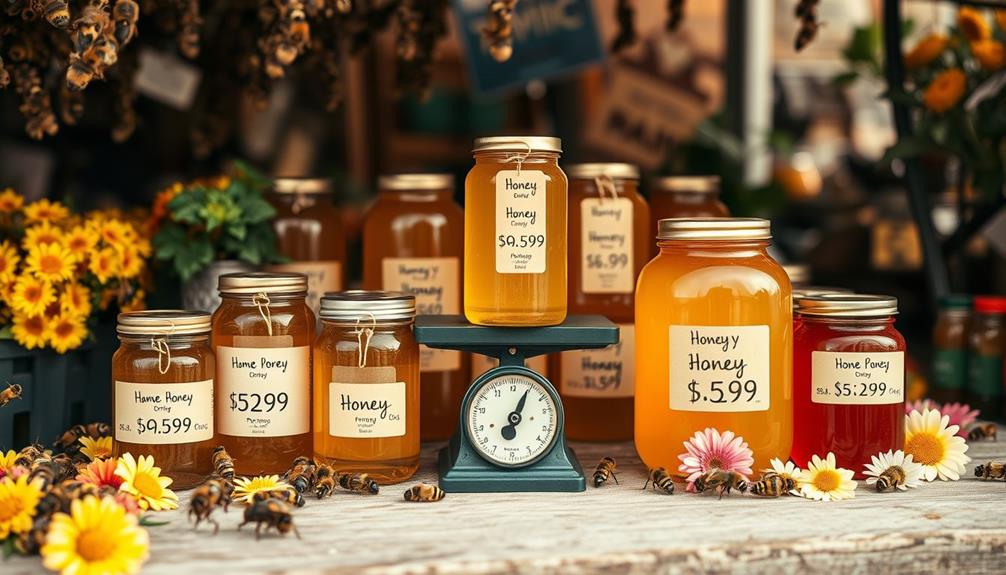
Effective pricing models play an essential role in successfully selling honey to wholesalers and retailers. You need to set competitive prices that balance profitability with market demand, typically ranging from 4 to 25 CHF per kilogram based on quality and packaging.
Understanding your budget is important as it helps you determine your cost structure and pricing flexibility. When dealing with wholesalers, remember that lower prices per unit may be necessary due to volume sales, which can impact your profit margins. Careful management of production costs is key in this scenario.
Consider price differentiation by offering various jar sizes, like 500g and 1kg. This caters to different customer preferences and maximizes your sales opportunities.
Establishing clear pricing structures that reflect product quality is significant; for example, pricing premium honey higher than standard offerings can enhance perceived value and attract health-conscious consumers.
Additionally, think about utilizing dynamic pricing strategies. By accounting for seasonal demand fluctuations and variations in annual honey yield, you can optimize your sales year-round.
Effective pricing models not only help you stay competitive but also provide a solid foundation for your honey business, ensuring that you meet both wholesaler and retailer needs while maintaining profitability.
Volume Discounts and Incentives

Offering volume discounts and incentives is a smart strategy to boost sales and encourage larger purchases from wholesalers and retailers. By providing discounts of 10-20% based on order quantities, you not only increase your sales volume but also create a compelling reason for buyers to choose your honey over competitors.
Additionally, understanding the importance of risk management strategies for investments can help you establish a solid foundation for your pricing models.
Implementing tiered pricing structures can motivate your customers to increase their order sizes, releasing progressively lower prices as they buy more. Establishing minimum order quantities guarantees that your pricing strategy supports your production and operational costs while making it clear to buyers what they need to achieve to receive discounts.
Additionally, promotional incentives like free shipping on bulk orders can enhance the attractiveness of purchasing larger quantities. These incentives make it easier for wholesalers and retailers to justify larger orders, knowing they'll save money in the long run.
Regularly engaging with your buyers about their purchasing patterns allows you to customize discount arrangements. This tailored approach not only fosters long-term business relationships but also builds loyalty among your customers, leading to repeat orders and sustained growth for your honey business.
Competitive Analysis and Market Trends
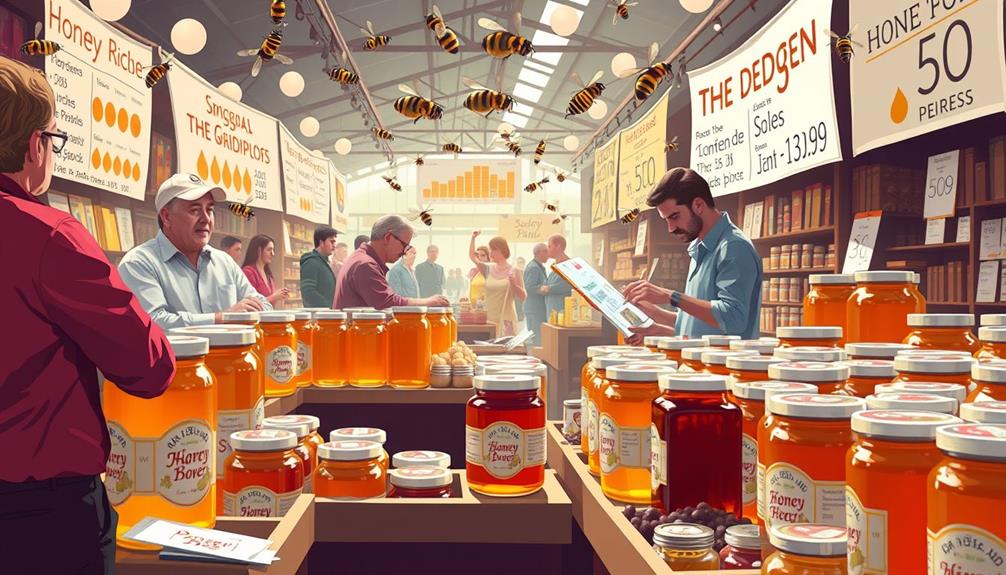
When you look at market pricing dynamics, you'll notice how competitor pricing strategies can impact your honey sales.
Understanding consumer trends can help you adjust your approach and stay ahead of the competition.
Market Pricing Dynamics
Understanding market pricing dynamics is vital for beekeepers aiming to maximize their profits. The average wholesale price for honey often dips below 4 euros per kilogram, so you need to evaluate your pricing strategies carefully to maintain profitability.
However, recent trends show a surge in consumer demand for high-quality, local honey. This shift allows you to potentially charge higher prices in both wholesale and retail channels.
Additionally, smaller local retailers generally offer more pricing flexibility than larger wholesalers. This can enable you to establish better relationships for direct sales, which can be beneficial for your bottom line.
Keep an eye on seasonal fluctuations in honey production, as lower yields can lead to increased prices during periods of scarcity.
Moreover, understanding local market conditions, including competitors' pricing, is essential. This knowledge helps you effectively position your honey products and optimize your sales strategies.
Competitor Pricing Strategies
Analyzing competitor pricing strategies is crucial for beekeepers looking to stay competitive in the honey market. To succeed, you need to closely examine the pricing structures of local and regional beekeepers.
Typically, wholesalers pay less than 4 euros per kilogram for bulk honey, which sets a benchmark for your pricing.
In Switzerland, the average retail price for honey ranges from 12 to 16 CHF per pound, influencing how you approach wholesale pricing to maintain competitive margins.
Keep an eye on market trends, as fluctuating demand and supply dynamics can greatly impact your pricing decisions and profitability.
Seasonal variations in honey production and quality also mean you must adjust your pricing strategy throughout the year.
Understanding your competitors' pricing, including any discounts or promotional offers, is crucial for establishing a competitive price that appeals to both wholesalers and retailers.
Consumer Trends Analysis
Consumer preferences are shifting rapidly, with an increasing demand for natural and organic products reshaping the honey market.
You'll notice that honey is now seen as a healthier alternative to refined sugars, which can greatly influence your pricing strategies. Consumers are also leaning towards locally sourced honey, favoring regional producers. This trend impacts competitive pricing as local offerings compete for attention.
Here are a few key insights to reflect on:
- Willingness to Pay: Consumers are ready to spend up to 25 CHF per kilogram for premium, organic honey.
- Supply Fluctuations: Environmental factors cause annual honey yield variations, leading to potential supply shortages and price adjustments.
- E-commerce Growth: Online platforms have changed buying habits, enabling producers to reach wider markets and set competitive pricing.
- Quality Focus: As consumers prioritize quality over quantity, you can differentiate your offerings by emphasizing high-quality attributes.
Legal Considerations for Pricing
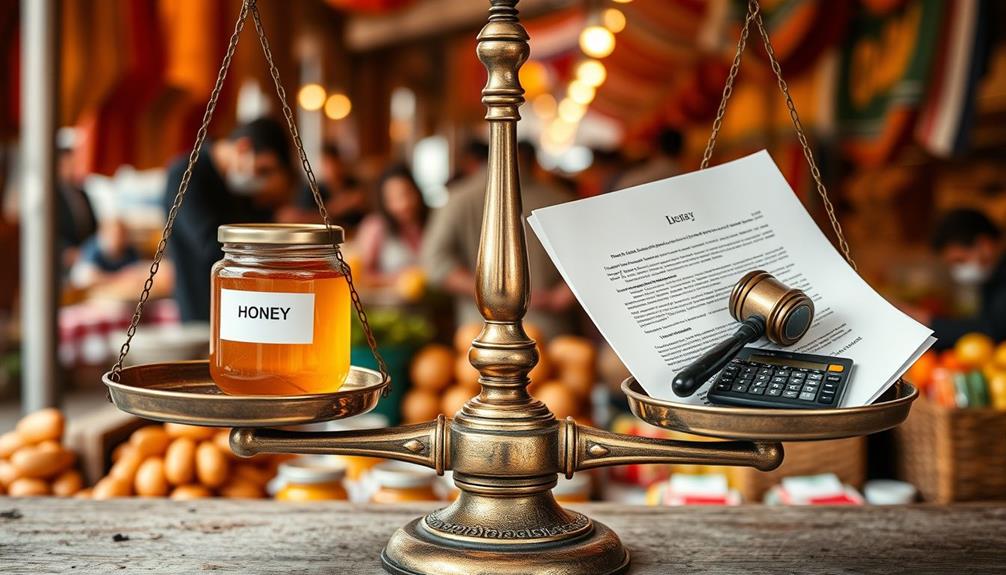
When pricing honey, it's important to navigate the legal landscape that affects your sales strategy. Local regulations may require you to obtain specific permits for pricing and selling honey, which can greatly impact your pricing strategies for both wholesalers and retailers.
You'll also need to comply with pricing laws that prevent deceptive practices, ensuring your pricing accurately reflects the quality and market value of your honey. Consulting with tax authorities is critical, as your pricing strategies for honey sales can influence your overall tax obligations, especially for larger transactions.
If you're involved with a non-profit association, be aware that strict limitations on economic activities can affect how you structure your prices. Additionally, the legality of pricing differences between cooperative sales and direct sales can vary.
It's important to understand cooperative agreements and their pricing implications to avoid potential legal issues. By staying informed about these legal considerations, you can develop a pricing strategy that not only meets market demands but also complies with all relevant regulations, ultimately supporting your long-term business goals.
Building Long-Term Customer Relationships

Understanding the legal considerations of pricing honey sets the stage for building long-term customer relationships that can drive your business forward.
By prioritizing effective communication and engagement, you can foster loyalty and encourage repeat business. Tools like Mailchimp for newsletters and WhatsApp Business for direct messaging can streamline your efforts.
Here are some strategies to enhance these relationships:
- Develop loyalty programs that reward repeat customers, boosting retention and average order values.
- Engage with informative content, such as recipes and health benefits of honey, to create a deeper connection with your audience.
- Personalize customer interactions by remembering past purchases and preferences, which can greatly enhance customer satisfaction.
- Regularly update customers on new products and special promotions to keep them engaged and reinforce their loyalty to your brand.
Frequently Asked Questions
How Do You Best Sell Honey?
To best sell honey, focus on quality and local appeal. Engage customers through markets and social media, offer competitive pricing, and utilize commission sales with retailers to increase visibility and reduce risk.
How Do You Market Honey Most Effectively?
You can make your honey marketing soar like a rocket by leveraging social media, creating compelling content, and engaging directly with customers. Don't forget to use eye-catching packaging and foster loyalty through regular communication.
What Do I Need to Consider if I Want to Sell Honey?
If you're selling honey, consider local regulations, quality assurance, and insurance coverage. Explore sales channels and think about pooling resources with other beekeepers to enhance your market presence and guarantee consistent product quality.
How Much Does 500G of Honey From the Beekeeper Cost?
When you buy 500g of honey directly from a beekeeper, expect to pay around 11 to 12.50 CHF. Prices may vary based on quality, packaging, and unique attributes the beekeeper offers.
Conclusion
In conclusion, mastering honey pricing strategies is essential for your success in selling to wholesalers and retailers. Did you know that nearly 75% of consumers prefer locally sourced honey? This statistic highlights the importance of not only competitive pricing but also building strong relationships with your customers. By understanding pricing factors, offering volume discounts, and staying informed on market trends, you can position yourself effectively and thrive in the sweet world of honey sales.






